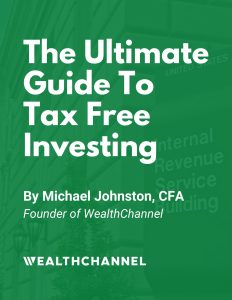Top line returns are, ultimately, irrelevant. As an investor, what matters is what you keep: what is left after the impact of fees, taxes, and inflation.
Of these three “drags” on a portfolio, taxes represent the biggest opportunity to optimize long-term returns for the vast majority of investors. In many cases, implementing a tax efficient investing strategy can translate into hundreds of thousands of dollars of incremental wealth.
This guide provides the “playbook” of strategies that virtually any investor can use to minimize their lifetime tax bill and maximize bottom line returns.

Free PDF Download
Get the full PDF version of this Ultimate Guide To Tax Free Investing.
Table of Contents
This guide is organized into several different chapters:
Chapter 1: Why Taxes Matter (And The One Big Myth)
Most investors fail to realize the potential impact of a tax efficient strategy on their portfolio. Understanding the magnitude of the role that taxes play in wealth creation — or wealth destruction — is the first step in implementing a tax efficient portfolio.
Chapter 2: The Four (Yes, Four) Taxes On Income
This chapter explains how your income is taxed by default, if you take don’t utilize any of the tax saving strategies available to you (hint: it isn’t pretty).
Chapter 3: Guiding Principles (And An “Aha Moment”)
Taxes may be complicated. But tax efficient investing can actually be simplified to just a couple of “golden rules.” Additionally, there are a few myths about taxes (and tax efficient investing) that trip up most investors. Chapter 3 will bust these myths, delivering an “aha moment” for investors.
Chapter 4: The 401(k) (Your Tax Free “Workhorse”)
The 401(k) is the “workhorse” of most American retirement accounts, thanks to its widespread availability and relatively high contribution limits. This chapter covers the basic strategies needed to get the most out of your 401(k), as well as some advanced strategies for high earners.
Chapter 5: IRA Strategy (And the Value of Flexibility)
IRAs are an incredibly powerful tool, but the different “flavors” adds a bit of complexity. Understanding the differences between Traditional and Roth is a critical step to tax efficient investing.
Chapter 6: Asset Location (And the Greatest Investment Ever Made)
Beyond getting as much money as possible into tax advantaged accounts, investors will be wise to make sure their holdings are in the right tax advantaged accounts.
